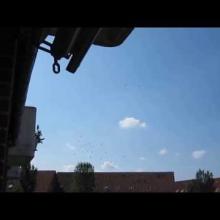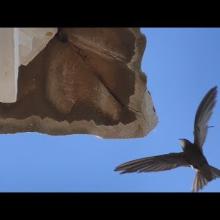

Join BirdNote tomorrow, November 30th!
Illustrator David Sibley and actor H. Jon Benjamin will face off in the bird illustration battle of the century during BirdNote's Year-end Celebration and Auction!
Geolocators are revolutionizing our ability to track migrating birds. When mounted on the backs of birds like this Common Swift, these tiny technological backpacks reveal fascinating information. For example, when researchers in Europe used geolocators to study Common Swifts, they discovered a large detour in their spring migration route. According to the researchers, “A sample size of six geolocator returns . . . revealed more information about migration and non-breeding sites for this species than 100 years of bird banding.”
BirdNote®
More Information than from 100 Years of Bird Banding
Written by Todd Peterson
This is BirdNote.
[Song of Bobolink]
New technology is revolutionizing our ability to track migrating birds and to locate where they go during our winter. This technology includes light-level geolocators, which when mounted on the backs of even small birds, record sunrise and sunset times. These readings, coupled with those from a clock in the geolocator, quite precisely mark a bird’s latitude and longitude.
[Song of Bobolink]
“We can now compare migration routes of widely separated populations (of birds) and quantify the severity and nature of threats (such as) urbanization, habitat loss, communication towers, wind turbines and the application of pesticides. For example, a crucial staging area for Bobolinks, identified using geolocators, coincides with an area in northern Venezuela where seed-eating birds have been intentionally poisoned.”1/
With geolocators, researchers in Europe discovered a large detour in the spring migration route of Common Swifts. [Call of Common Swift] The birds are jogging west apparently to take advantage of an abundance of insects in a small area of Liberia before crossing the Sahara Desert. 2/
[The research team reported that] “A sample size of six geolocator returns from the Common Swift revealed more information about migration and non-breeding sites for this species than 100 years of bird banding.” 3/
[Call of Common Swift]
There’s more to this story at birdnote.org.
###
Bird sounds provided by The Macaulay Library of Natural Sounds at the Cornell Lab of Ornithology, Ithaca, New York. Song of Bobolink [012419] recorded by A.A. Allen.
Calls of Common Swift [138594] from xeno-canto recorded by Lars Lachmann.
BirdNote’s theme music was composed and played by Nancy Rumbel and John Kessler.
Producer: John Kessler
Executive Producer: Chris Peterson
© 2013 Tune In to Nature.org November 2017 Narrator: Mary McCann
ID# geolocator-04-2013-11-30geolocator-04
1, 2 &3/. McKinnon, Emily A., Kevin C. Fraser and Bridget M. Stutchbury, “New Discoveries in Landbird Migration Using Geolocators, and a Flight Plan for the Future.” The Auk, An International Journal of Ornithology. Vol.130 No. 2 April 2013.






